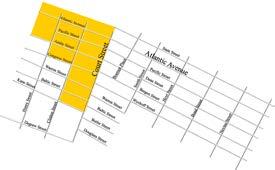HISTORIC PRESERVATION STUDIO II
Diversity The ethnic history of the study area sheds light on the origins and development of what the studios has identified as one of the important character-defining features of we have identified as one of the most important character-defining features of the neighborhood’s architectural fabric today: a diversity of residents. Beginning in hte middle of hte nineteenth century, the study of the area was defined by its high degree of racial and ethnic diversity. Several groundbreaking policies enacted during Seth Low's second term as Mayor of Brooklyn illustrate the pressing issue sof race and ethnicicity in the study area even at that time. For example in 1881, Low conditionally allowed the German beer gardens and other “saloons” to remain open during the Sabbath, despite strict prohibitions on other activities.1 The conciliatory move by Low demonstrates the ways in which the multicultural society of Brooklyn at the same time was able to extert a powerful influence on politics. Mayor Low also passed radical education reforms that desegregated schools and provided textbooks to all students for free.2 Again, these policies highlight the fact that the borough as a whole had a significant degree of racial and ethnic diversity at the time. Ultimately however, Seth Low awas considered an unpopular mayor overall, especially after raising property taxs in 1883..3 By 1890, the population density on developed land in Brooklyn was 53.16 persons to the acre, with 82,282 dwellings in the city housing an average occupancy of 9.8 persons.4 As we have observed, the population density of the study area was initially low, but dramatically increased by the turn of the century as a significant number of immigrants settled in the United States. By 1855, 35.1% of Brooklyn residents reported New York as place of birth, a significant drop from the 51.9% just ten years earlier in 1845.5 During the late nineteenth, early twentieth century, the study area was beset by epidemics including yellow fever and cholera beset and decimated the study area population, a loss soon filled by an influx of immigrants from Ireland, Italy, and Germany.6 An especially diverse immigrant and migrant population resided in the study area in the twentieth century and made an important impact on the built environment. The different groups included Germans, Irish, Italians, Syrians, and especially beginning in the 1950s, Puerto Ricans and African Americans. During this period of the mid-twentieth century, the City of New York cleared six blocks in the area below what is now Boerum Hill and replaced the leveled area with affordable public housing projects. These projects included the 1948 Gowanus Houses, and later the 1966, Wyckoff Gardens.7 The significance of the study area is drawn in part from its diverse groups of residents and the influence they had on the architectural fabric of the area. The study area is significant for its reflection of rapidly changing community values within a built environment that in some places has changed very little, especially in terms of scale, materials, and typology. Given the pressures of a growing population and the associated need for housing development, as well as a widening disparity of wealth and income across the country, this small area of Brooklyn presents an important opportunity to look at how the preservation of buildings can and cannot meet the needs of a transitioning community. The study area’s consistency in scale has partially contributed to an inconsistency in the different groups of people who “had to” live here, “chose to” live here, or are “able to afford to” live here (i.e. immigrants, then first waves of “brownstoners,” and then high-income residents of today). With all of this to consider, the study area presents an opportunity to develop strategies for including historically diverse residents and their different needs within a community that architecturally is restricted--considered underbuilt but also in some areas, legally regulated--in its ability to respond to change.
1 Gerald Kurland, Seth Low: the Reformer in an Urban and Industrial Age. (1971), 149 2 Ibid., 42-3 3 Ibid., 41 4 Vital Statistics of New York City and Brooklyn (1890), 165 5 Jacob Judd, The history of Brooklyn: 1834-1855. (diss. 1959), 21 6 Boerum Hill Historic District Extension Proposal, 9 7 Boerum Hill Historic District Extension Proposal, 11
A STUDY OF BROOKLYN’S COBBLE HILL & BOERUM HILL NEIGHBORHOODS 115




















